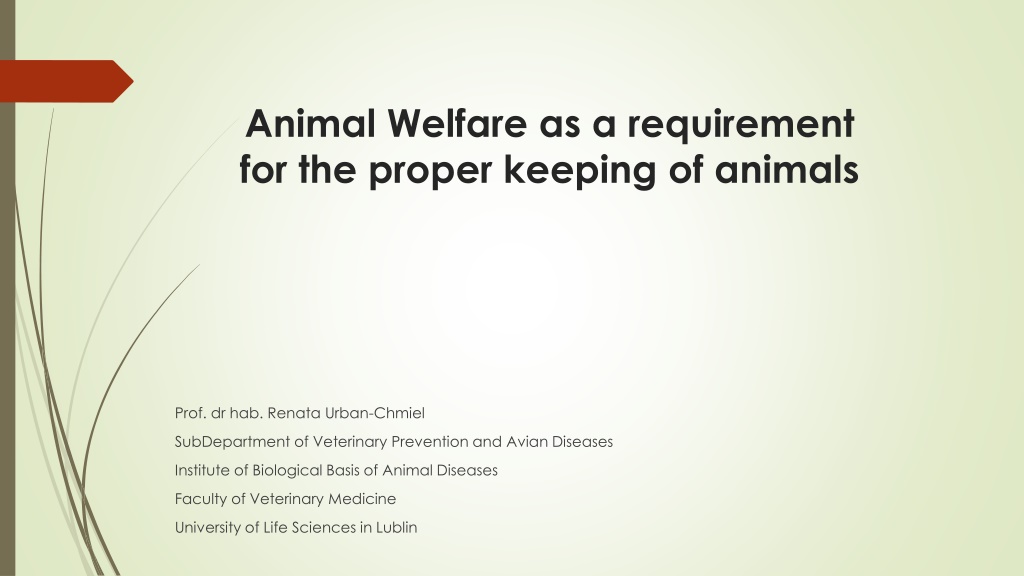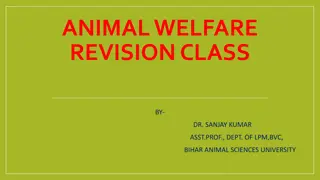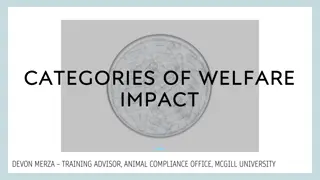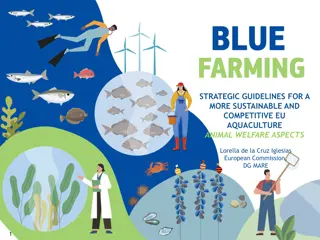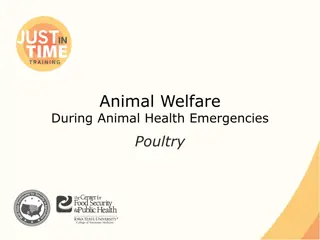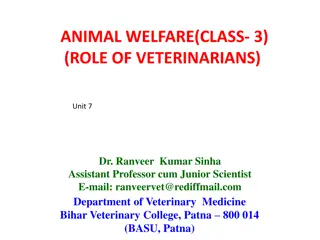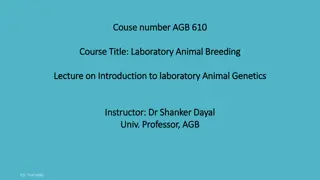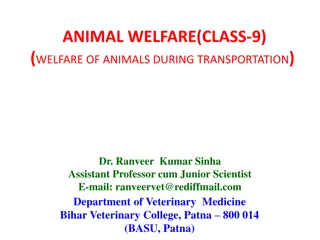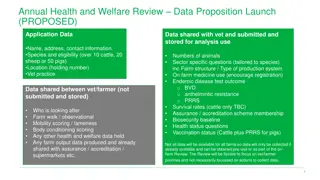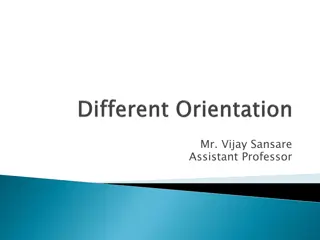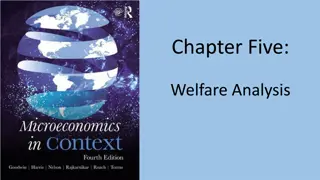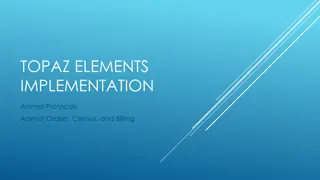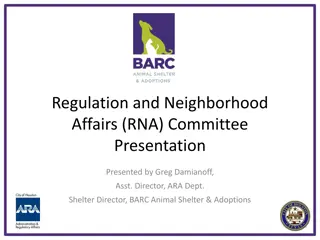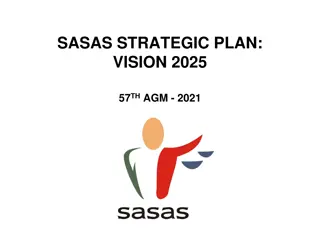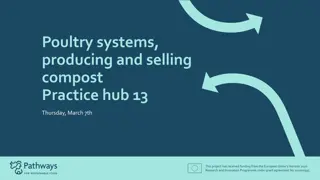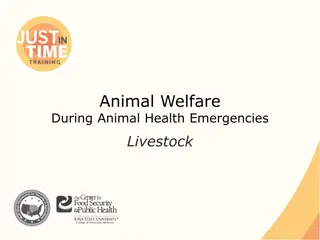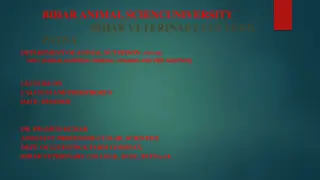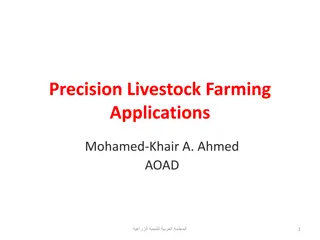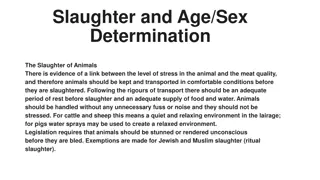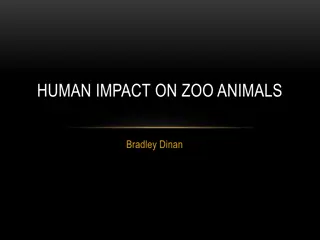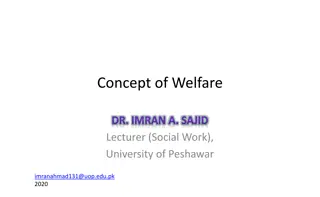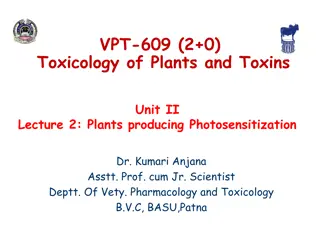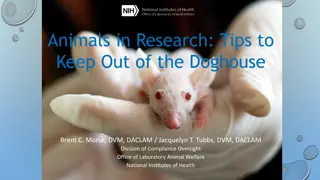Understanding Animal Welfare and Good Condition for Proper Care
Explore the concept of animal welfare, emphasizing the importance of ensuring animals under human care do not suffer unnecessarily. Learn about the various perspectives, definitions, and considerations related to the well-being of animals in different environments and contexts.
Uploaded on Oct 04, 2024 | 0 Views
Download Presentation

Please find below an Image/Link to download the presentation.
The content on the website is provided AS IS for your information and personal use only. It may not be sold, licensed, or shared on other websites without obtaining consent from the author. Download presentation by click this link. If you encounter any issues during the download, it is possible that the publisher has removed the file from their server.
E N D
Presentation Transcript
Animal Welfare as a requirement for the proper keeping of animals Prof. dr hab. Renata Urban-Chmiel SubDepartment of Veterinary Prevention and Avian Diseases Institute of Biological Basis of Animal Diseases Faculty of Veterinary Medicine University of Life Sciences in Lublin
The Welfare definitions welfare - A term that reflects global trends in creation the living conditions of farm, domestic and laboratory animals. - Phenomenon containing norms of human behavior in relation to wild animals living in the human environment (rodents), zoos or urbanized ecosystems.
The welfare definitions Animal welfare is the viewpoint that animals, especially those under human care, should not suffer unnecessarily, including where the animals are used for food, work, companionship or research. This position usually focuses on the morality of human action (or inaction), as opposed to making deeper political or philosophical claims about the status of animals, as is the case for an animal rights viewpoint. For this reason animal welfare organizations may use the word humane in their title or position statements.
the good condition concerns the body as a whole and covers all its functions (parameters), psychic reactions (emotions, feelings, ideas) phenomena - processes occurring at the cellular level. Interactions between different levels of well-being and the biological balance of the system concern the entire life span starting from prenatal development and are subject to modifications resulting from external and internal environment variables. Many authors define well-being as a state of physical and mental health, achieved in conditions of full harmony of the system in its environment (Hughes).
In the light of their function in the process of making a concept a men able to scientific research, we will distinguish between three kinds of definitions: lexical definitions, explanatory definitions operational definitions.
We will use the term 'lexical [dictionary] definition' to refer to a denotation of the common meaning of a word. Such a definition can give, for example, a synonym which has more or less the same meaning or give a phrase which reflects the meaning. Sometimes a word denotes a concept. A conceptis a general notion and contains different related aspects. Since animal welfare is an abstract concept which is relatively new, we may expect to find different interpretations of these aspects.( Fraser1995.)
Definition according to Lorenz A state of mental and physical harmony between the animal and the environment, enabling the fulfillment of specific species needs (in the field of physiology, ethology and health). Definition according to Tinbergen Animal condition in which all species and age behaviors are unrestricted.
Konrad Lorenz 1903-1989 Nicolas Tinbergen 1907-1988 The nederlands ethologists and behaviourists The Nobel prize lateats in 1973 year in physiology and medicine For discoveries regarding the ethology of animal societies
Definition according to Broom The state of the system in which the animal can "cope" with the circumstances surrounding it. Definition according to Brantas When the animal is well suited to its environment, it can maintain its physiological balance, when it is free from pain and disease, it can behave undisturbed and when evident suffering is ruled out.
Donald M. Broom (born 1942 )-Professor of Animal Welfare at Cambridge University Developing and using methods of evaluating animal welfare. Behaviour development, social and abnormal behaviour. Assessing cognitive ability in domestic animals including cattle, pigs, sheep and dogs. Sentience, awareness, emotions, feelings, needs, stress, coping, empathy. Sustainable livestock production, silvopastoral systems. Ethics in relation to animal usage. Morality. Biological basis of religion.
D. M. Broom Dept. of Clin. Vet. Med., Cambridge Univ., UK. The term "welfare" refers to the state of an individual in relation to its environment, and this can be measured. Difficulty in coping are indicators of poor welfare. Suffering and poor welfare often occur together, but welfare can be poor without suffering and welfare should not be defined solely in terms of subjective experiences.
According to Sainsbury , 'welfare' is a set of conditions covering the biological and behavioral needs of an organism, which allows revealing the fullness of its genetic capabilities.
The 'coping' ability is related to the functions of the cortical structures of the brain that synchronize information from the external environment with the metabolic activity of the body. Impaired welfare occurs when the system is unable to correctly assess the situation, and then actively counteract adverse changes in the environment, or when the changes are unpredictable for the animal.
Hence, it follows that 'well-being' means more than physical or biological comfort, because it also takes into account emotional balance depending on the ability to meet species and individual behavioral norms.
Also suggest that well-being is closely linked to environmental factors, which also affect animals, and is a set of conditions that cover the biological and behavioral needs of the body, which allows it to fully reveal its genetic potential.
Basic welfare requirements according to the Farm Animal Welfare Committee, UK. Many animal welfare scientists consider that the 5 Freedoms form a useful minimum checklist we can use to assess animal farming practices: 1. Free from thirst and hunger - direct access to fresh water and a diet ensuring full health and vigor. 2. Free from thermal or physical discomfort - providing the appropiate environment, including shelter and comfortable resting area.
3. Freedom from pain, injury and disease: by prevention or rapid diagnosis and treatment. 4. Freedom to express normal behaviour: by providing sufficient space, proper facilities and company of the animal s own kind . 5. Freedom from fear and distress: by ensuring conditions and treatment which avoid mental suffering.
The welfare of an animal includes its physical and mental state and we consider that good animal welfare implies both fitness and a sense of well-being. [Dobrostan zwierz cia obejmuje jego stan fizyczny i psychiczny i uwa amy, e dobry dobrostan zwierz t oznacza zar wno sprawno fizyczn , jak i dobre samopoczucie] Farm Animal Welfare Council. www.fawc.org.uk
The concepts which defining the welfare (well-being) Stress, Tolerance, Adaptation, Condition, Homeostasis.
Response levels that reflect the adaptation of animals to environmental conditions (McBride): The first level refers to predominantly behavioral response - takes into account behaviors such as avoiding risk based on acquired experience ('retreat'), - grouping ('hugging'), typical in low ambient temperature conditions. Emma McBride- a Federal Member for Dobell, welfare, well- beign This reactions are linke with accompanied short-lived (co- occurring) physiological reactions (increase in the frequency of breaths and heart rate, muscle tremors), which, however, do not necessarily have the effect of reducing the biotic potential.
If the first level does not compensate for loads, then the reactions take place at the second level, where the predominantly physiological response is dominant, Occurs with the participation of the neuro-endocrine system and the autonomic nervous system, and the behavioral response is a co-occurring response. The cost of the second level reaction is much higher for the body, which is manifested in a decrease in growth and fertility rates, as well as deterioration of animal health.
Welfare [Well-being] is an opposition to stress !!!
An animal is in a state of stress when its body must use abnormal or extreme adaptation options in physiological or behavioral responses to stay alive in the face of environmental conditions that have changed to its disadvantage.
Stress: - disrupts the body's hormonal homeostasis, - all its somatic and mental functions controlled by the neuro-endocrine system.
Nastpstwa Restriction of freedom of movement Reduced perception Fight for dominance in the herd The fight for food Injuries
The indicators of poor welfare include the following (acc. to Broom): reduced life expectancy, impaired growth, impaired reproduction, body damage, disease, immunosuppression, adrenal activity, behavior anomalies, stereotypies, self-narcotization.
High level of well-being manifesting various forms of normal behavior, maintaining physiological indicators in the standard, maintaining behavioral standards in the norm
The pathological reactions The abnormal behaviour Stereotypies and auto narcotism The health disturbances
The Polish legislation about animal welfare 29 The President of Republic of Poland Act 21 August 1997 r. About Animal Protection . (Dz. U. z dnia 23 wrze nia 1997 r.) The novelisation of The President of Republic of Poland Act 6 June 2002 r. About the changing of Act about animal protection (Dz. U. Z dnia 28 Aug 2002 04.10.2024
ACT of the President of the Republic of Poland 30 of 16 September 2011 "On the amendment to the Act on the protection of animals and the Act on maintaining cleanliness and order in municipalities OJ No. 230, item 1373 04.10.2024
REGULATIONS OF THE MINISTER OF AGRICULTURE AND RURAL DEVELOPMENT 31 of February 15, 2010 (Journal of Laws 56 item 344) "On the requirements and procedure for maintaining farm animal species for which protection standards have been laid down in European Union legislation. of 28 June 2010 "On minimum conditions for keeping farmed animal species other than those for which protection standards have been laid down in European Union legislation. " 04.10.2024
Animal species included in the subject 'animal welfare - Livestock animals (horses, cattle, sheep and goats, pigs), - Accompanying animals (e.g. dogs, cats, other), - Poultry (chickens, ducks, geese, ostriches), - Laboratory animals (mice, rats, hamsters, primates, etc.) - Exotic animals - (konie, byd o, owce i kozy, winie),
Animal welfare level analysis: - Assessment of basic welfare indicators physiological behavioral health production ethical complementary (supplementary) economic
Physiological indicators of welfare (well-being) Pulse rare Breaths frequency Blood glucose Urea concentration Catecholamine level
Free corticosteroid levels Degree of lipid peroxidation Oxidative status of the body Change in reactivity of immunological parameters
The behavioral indicators of animal welfare - Behavioral patterns (norms) - Behavioral pathologies (stereotype, self-drug addiction) Auto-drug addiction is an addiction to the beta-endorphin released by the brain. This addiction develops in animals in the following conditions: - Boring (no environmental stimulation) - Frustration - Restrictions on freedom Overreaction in chronic situations or repeated tensions. This condition is considered an adaptive mechanism that reduces the degree of exposure of physiological systems to damage resulting from neuroendocrine disorders.
Stereotypies are abnormal behaviors with etiologies that are not fully understood, which are repeated very often and without a clear purpose. They are translated by some as an expression of inability to adapt (coping), which leads to damage to physiological systems. They occur in animals of various intensities as: - Permanent - recurrent - senseless behavior - self-destructive behavior.
Health welfare indicators Health means the absence of specific reactions of physiological systems to the presence of a pathogenic agent or other damaging factors. It completely falls within the concept of well-being. It is one of its criteria and is subject to a scale similar to well- being, i.e. from very good to very bad health. Good health may be accompanied by a reduced level of well- being, which is to be expected sooner or later to worsen health.
Poor health always means poor well-being. The consequences of impaired well-being occur at both the individual and population levels. The individual level applies to individual herds in the herd or small groups, without mass effects. It focuses on the mutilation of animals as a result of "aggression" of physical factors of the environment or contact with other individuals.
Factors affecting the reduced level of livestock health - density of stocking dens, - use of tethering, - windowless maintenance, - litterless and unattempted, - manipulation of individuals and groups (disconnecting, weighing, driving, moving, catching, tattooing, cutting the ears, cutting off germs and petioles, grafting, castration), - work of mechanical devices, - improper human-animal relationship.
Production indicators of animal welfare Production level High Optimum Low Dependence of the amount of production on the regenerative capacity of the body Degree of production load: milk production, meat, eggs production, reproduction
Ethical welfare indicators The absolute limit of welfare is the degree of burden to which animals can adapt without suffering. In conditions of inadequate welfare, animal feelings are always bad (bad feelings) and can be compounded up to suffering. Feelings can be measurable by methods adopted in medical diagnostics: (brain potential registration, blood flow rate, heart rate, degree of pupil dilation),
Based on observation of animal behavior apathy, lack of appetite, abandonment of hygiene procedures, hyperactivity, aggression, vocalization Incidence rates and biotic potential (reproduction, growth dynamics, survival). The suffering of animals arises from at least three sources, each of which can be the cause of an equally intense experience.
The sources of somatic suffering are: pain, hunger, thirst, cold, heat and other loads that cause reactions with the reception of stimuli by means of sensory impressions that fall within the scope of physiological concepts. Another source relates to the emotional sphere. The gradation of anxiety, from anxiety to panic fear, results from unfriendly or dangerous situations, as well as unpredictable events that the individual (s) cannot or cannot avoid. The rise of panic fear can be observed in groups of currently not disturbed pigs, only as a result of receiving information about the pain and threat that other animals experience, e.g. during castration and slaughter. The cause of fear may be the displacement of the animal to an unknown place or a foreign group, isolation, aggression of dominant animals and traumatic devices.
The third, now more and more often signaled source of suffering for farm animals is: the inability to manifest and then satisfy strong, innate, species-specific drives and instincts. These types of restrictions are typical for industrial farms designed without the most basic behavioral needs of animals. Restrictions on instincts trigger a state of severe frustration in animals, leading to serious somatic disorders and stereotypes, to self-harm and cannibalism. theconversation.com
Alternative animal housing systems by introducing elements that partially meet the needs (litter, living space, increased fiber content in feed) are evolving towards a semi-natural habitat.
Supplementary welfare indicators Technical and technological parameters of the livestock building Heat protection values of structural partitions Type of materials used for the construction Efficiency of ventilation and heating systems Ways to limit animal freedom.
Economic criteria for animal welfare Qualification of health and production losses resulting from a reduced level of well-being. Choosing a strategy to minimize losses. Balance of financial outlays to improve welfare and profits resulting from these activities.
Animal Welfare Index Analysis: The Evaluation of Environmental, housing system. Assessment of animal social contacts. Classification of substrate quality. The evaluation of basic parameters of the room microclimate. Assessment of health, production and appearance of animals.
The animal welfare index analysis- an example The housing system number No ..; the animal species .. b c d e f g Total points Influence factros Movement possibility Free stalls system Ca kowita przestrze ruchu Total movement space, area With corns animals Tether system Free space Pasture Size of stall Kind of tether Social contacts Herd structure Kind of housing, breeding Movemenet possibility-free space, area Pasture Without corns anim. Floor quality Kind of laying area Cleanliness The ability to display a range of activities Movement possibility- free area Softness, Regurality of slop (nachylenie) Microclimate parameters Lighting Type and efficiency of the ventilation system Possibility of movement within the laying area - visibility Possibility of movement outside the livestock building Days/year The cleanliness of the animals Hours/day Condition of limbs, feet Quality of care Cleanliness in the livestock building The condition of the livestock building equipment Animal condition - skin, mucous membranes Technopaties prevalence Evaluation of animal care - the possibility of supervising Total pkt of all parameters= Animal Welfare Indeks The minimal conditions have been met have not been met Because of (Due to) Sundrum, 1993 with Urban-Chmiel modification, 2018
